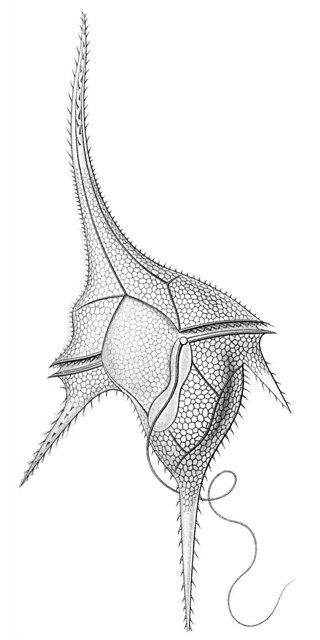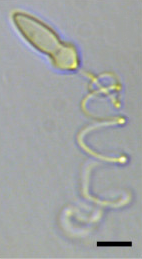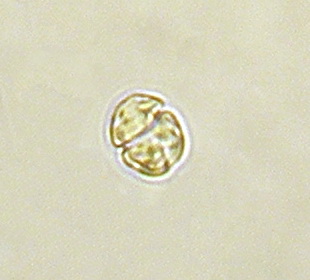
The dinoflagellates are a monophyletic group of single-celled eukaryotes constituting the phylum Dinoflagellata and are usually considered protists. Dinoflagellates are mostly marine plankton, but they also are common in freshwater habitats. Their populations vary with sea surface temperature, salinity, and depth. Many dinoflagellates are photosynthetic, but a large fraction of these are in fact mixotrophic, combining photosynthesis with ingestion of prey.

Dinokaryota is a main grouping of dinoflagellates. They include all species where the nucleus remains a dinokaryon throughout the entire cell cycle, which is typically dominated by the haploid stage. All the "typical" dinoflagellates, such as Peridinium and Gymnodinium, belong here. Others are more unusual, including some that are colonial, amoeboid, or parasitic. Symbiodinium contains the symbiotic zooxanthellae.

Karenia brevis is a microscopic, single-celled, photosynthetic organism in the genus Karenia. It is a marine dinoflagellate commonly found in the waters of the Gulf of Mexico. It is the organism responsible for the "Florida red tides" that affect the Gulf coasts of Florida and Texas in the U.S., and nearby coasts of Mexico. K. brevis has been known to travel great lengths around the Florida peninsula and as far north as the Carolinas.
Alexandrium fundyense is a species of dinoflagellates. It produces toxins that induce paralytic shellfish poisoning (PSP), and is a common cause of red tide. A. fundyense regularly forms massive blooms along the northeastern coasts of the United States and Canada, resulting in enormous economic losses and public health concerns.
Alexandrium tamarense is a species of dinoflagellates known to produce saxitoxin, a neurotoxin which causes the human illness clinically known as paralytic shellfish poisoning (PSP). Multiple species of phytoplankton are known to produce saxitoxin, including at least 10 other species from the genus Alexandrium.

Karenia is a genus that consists of unicellular, photosynthetic, planktonic organisms found in marine environments. The genus currently consists of 12 described species. They are best known for their dense toxic algal blooms and red tides that cause considerable ecological and economical damage; some Karenia species cause severe animal mortality. One species, Karenia brevis, is known to cause respiratory distress and neurotoxic shellfish poisoning (NSP) in humans.

Karlodinium is a genus of athecate dinoflagellates that lives worldwide. They are often toxin producing, and compared to the other members of the Kareniaceae, are fairly small at <8-15 µm diameter. They are also able to form intense algal blooms. This species relies of photosynthesis and phagotrphy to grow.

Akashiwo sanguinea is a species of marine dinoflagellates well known for forming blooms that result in red tides. The organism is unarmored (naked). Therefore, it lacks a thick cellulose wall, the theca, common in other genera of dinoflagellates. Reproduction of the phytoplankton species is primarily asexual.
Alexandrium catenella is a species of dinoflagellates. It is among the group of Alexandrium species that produce toxins that cause paralytic shellfish poisoning, and is a cause of red tide. ‘’Alexandrium catenella’’ is observed in cold, coastal waters, generally at temperate latitudes. These organisms have been found in the west coast of North America, Japan, Australia, and parts of South Africa.

Polykrikos kofoidii is a species of phagotrophic marine pseudocolonial dinoflagellates that can capture and engulf other protist prey, including the toxic dinoflagellate, Alexandrium tamarense. P. kofoidii is of scientific interest due to its status as a predator of other dinoflagellates, a behavior that is significant in the control of algal blooms. It has a complex life cycle of both vegetative (asexual) and sexual reproduction complicated by its pseudocolonial structure.
Karenia selliformis is a species from the genus Karenia, which are dinoflagellates. It was first discovered in New Zealand. Karenia selliformis produces the highly toxic gymnodimine, and as such is a potentially harmful ocean dweller. Gymnodimine is a nicotinic acetylcholine receptor-blocking phycotoxin, a source of shellfish poisoning.

The Polykrikaceae are a family of athecate dinoflagellates of the order Gymnodiniales. Members of the family are known as polykrikoids. The family contains two genera: Polykrikos and Pheopolykrikos.

Gambierdiscus is a genus of marine dinoflagellates that produce ciguatoxins, a type of toxin that causes the foodborne illness known as ciguatera. They are usually epiphytic on macroalgae growing on coral reefs.

Dinoflagellates are eukaryotic plankton, existing in marine and freshwater environments. Previously, dinoflagellates had been grouped into two categories, phagotrophs and phototrophs. Mixotrophs, however include a combination of phagotrophy and phototrophy. Mixotrophic dinoflagellates are a sub-type of planktonic dinoflagellates and are part of the phylum Dinoflagellata. They are flagellated eukaryotes that combine photoautotrophy when light is available, and heterotrophy via phagocytosis. Dinoflagellates are one of the most diverse and numerous species of phytoplankton, second to diatoms.

Polykrikos is one of the genera of family Polykrikaceae that includes athecate pseudocolony-forming dinoflagellates. Polykrikos are characterized by a sophisticated ballistic apparatus, named the nematocyst-taeniocyst complex, which allows species to prey on a variety of organisms. Polykrikos have been found to regulate algal blooms as they feed on toxic dinoflagellates. However, there is also some data available on Polykrikos being toxic to fish.
Coolia is a marine dinoflagellate genus in the family Ostreopsidaceae. It was first described by Meunier in 1919. There are currently seven identified species distributed globally in tropical and temperate coastal waters. Coolia is a benthic or epiphytic type dinoflagellate: it can be found adhered to sediment or other organisms but it is not limited to these substrates. It can also be found in a freely motile form in the water column. The life cycle of Coolia involves an asexual stage where the cell divides by binary fission and a sexual stage where cysts are produced. Some of the species, for example, Coolia tropicalis and Coolia malayensis, produce toxins that can potentially cause shellfish poisoning in humans.
Torodinium (ˌtɔɹoʊˈdɪniəm) is a genus of unarmored dinoflagellates and comprises two species, Torodinium robustum and the type species Torodinium teredo. The establishment of Torodinium, as well as the characterization of the majority of its morphology, occurred in 1921 and further advances since have been slow. Lack of research is largely due to its extremely fragile and easily deformed nature, which also renders fossil records implausible. The genus was originally characterized by torsion of the sulcus and a posterior cingulum. Since then, new distinctive features have been discovered including an extremely reduced hyposome, a longitudinally ribbed episome, and a canal on the dextro-lateral side. Further investigation into the function of many anatomical features is still necessary for this genus.
Karlodinium armiger is a species of dinoflagellates belonging to the family Kareniaceae. It was first isolated from the Mediterranean sea & described in 2006.

Gymnodiniaceae is a family of dinoflagellates belonging to the order Gymnodiniales.
Lepidodinium is a genus of dinoflagellates belonging to the family Gymnodiniaceae. Lepidodinium is a genus of green dinoflagellates in the family Gymnodiniales. It contains two different species, Lepidodiniumchlorophorum and Lepidodinium viride. They are characterised by their green colour caused by a plastid derived from Pedinophyceae, a green algae group. This plastid has retained chlorophyll a and b, which is significant because it differs from the chlorophyll a and c usually observed in dinoflagellate peridinin plastids. They are the only known dinoflagellate genus to possess plastids derived from green algae. Lepidodinium chlorophorum is known to cause sea blooms, partially off the coast of France, which has dramatic ecological and economic consequences. Lepidodinium produces some of the highest volumes of Transparent Exopolymer Particles of any phytoplankton, which can contribute to bivalve death and the creation of anoxic conditions in blooms, as well as playing an important role in carbon cycling in the ocean.









